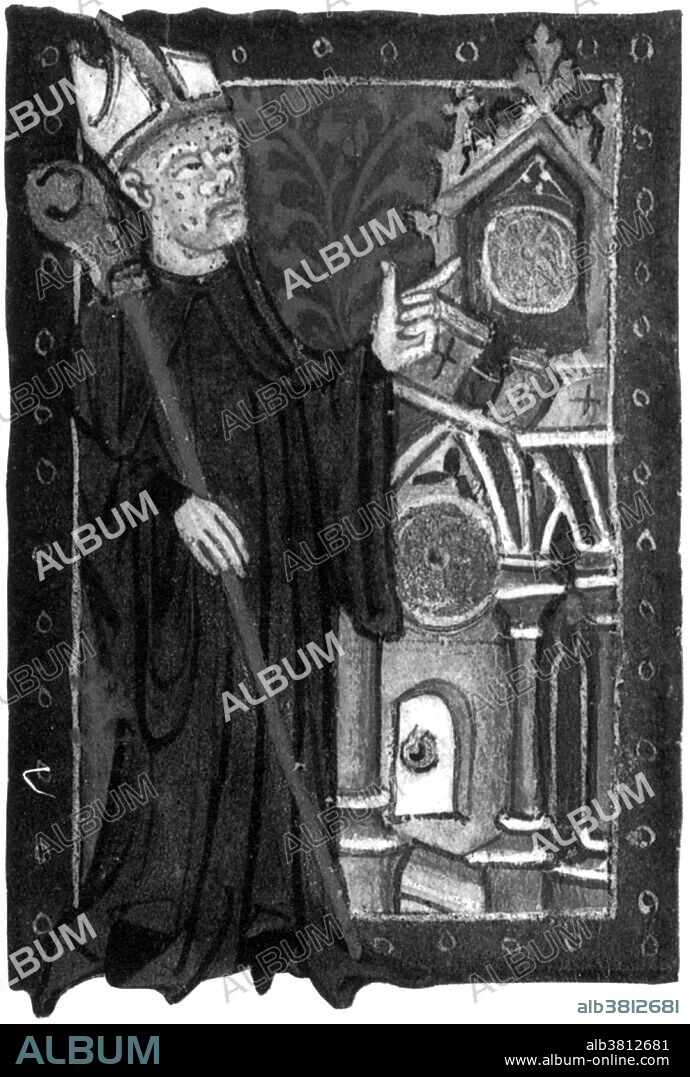alb3812681
Richard of Wallingford, English Mathematician

|
Zu einem anderen Lightbox hinzufügen |
|
Zu einem anderen Lightbox hinzufügen |



Haben Sie bereits ein Konto? Anmelden
Sie haben kein Konto? Registrieren
Dieses Bild kaufen.
Nutzung auswählen:

Titel:
Richard of Wallingford, English Mathematician
Untertitel:
Siehe automatische Übersetzung
Richard of Wallingford (1292-1336) was an English mathematician who made major contributions to astronomy, astrology and horology while serving as abbot of St Albans Abbey. He is best known for the astronomical clock he designed, while he was abbot, which is described in the Tractatus Horologii Astronomici (1327). The clock was completed about 20 years after Richard's death by William of Walsham but was apparently destroyed during Henry VIII's reformation and the dissolution of St Albans Abbey in 1539. His clock almost certainly was the most complex clock mechanism in existence at the time in the British isles, and one of the most sophisticated ones anywhere. He also designed and constructed a calculation device, known as an equatorium, which he called Albion. This could be used for astronomical calculations such as lunar, solar and planetary longitudes and could predict eclipses. This is described in the Tractatus Albionis. He published other works on trigonometry, celestial coordinates, astrology, and various religious works. He suffered from what was then thought to be leprosy (might have been scrofula or tuberculosis) and died in 1336.
Bildnachweis:
Album / Science Source / New York Public Library
Freigaben (Releases):
Model: Nein - Eigentum: Nein
Rechtefragen?
Rechtefragen?
Bildgröße:
3150 x 4674 px | 42.1 MB
Druckgröße:
26.7 x 39.6 cm | 10.5 x 15.6 in (300 dpi)
Schlüsselwörter:
13. JAHRHUNDERT • 13. JH. • ASTRONOMIE • ASTRONOMISCHE UHR • BERÜHMT • BERÜHMTE PERSÖNLICHKEIT • BLOCK-DRUCK • DESIGNER • ERFINDER • EUROPAEER (F M) • EUROPAEER • EUROPÄER (F M) • EUROPÄER • EUROPÄISCH • GEISTLICHER: MOENCH • GEISTLICHER: PRIESTER • HOLZARBEIT: SCHNITZEREI • ILLUSTRATION • ILLUSTRATIONS • KATHOLIK • KATHOLISCH • LAZARUSKLAPPER (LEPRA) • LEPRA • MANN • MOENCH • MOENCHE • MÖNCH • NOTABEL • PERSON • PERSöNLICHKEITEN • PERSÖNLICHKEITEN • PFARRER • PRIESTER • PROMINENZ • SCHNITZEREI: HOLZ • TECHNIK: HOLZSCHNITT • WISSENSCH.: ASTRONOMIE
 Pinterest
Pinterest Twitter
Twitter Facebook
Facebook Link kopieren
Link kopieren Email
Email
